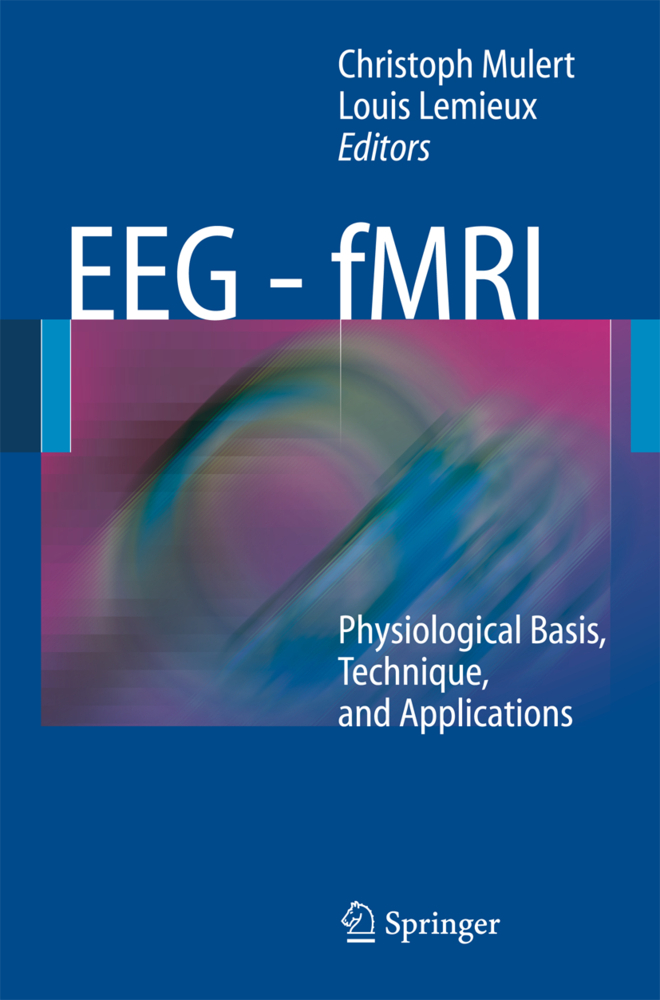EEG - fMRI
Functional magnetic resonance imaging (fMRI) and Electronecephalography (EEG) are very important and complementary modalities since fMRI offers high spatial resolution and EEG is a direct measurement of neuronal activity with high temporal resolution. Interest in the integration of both types of data is growing rapidly as it promises to provide important new insights into human brain activity as it has already done so in the field of epilepsy. The availability of good quality instrumentation capable of providing interference-free data in both modalities means that electrophysiological and haemodynamic characteristics of individual brain events can be captured for the first time. Consequently, it seems certain that the integration of fMRI and EEG will play an increasing role in neuroscience and of the clinical study of brain disorders such as epilepsy.
The proposed book will discuss in detail the physiological principles, practical aspects of measurement, artefact reduction and analysis and also applications of the integration of fMRI and EEG. All applications, which are mainly in the fields of sleep research, cognitive neuroscience and clinical use in neurology and psychiatry will be reviewed.
1;Foreword;5 2;Preface;7 3;Contents;10 4;Contributors;20 5;Part I Background;23 5.1;1 Principles of Multimodal Functional Imaging and Data Integration;24 5.1.1;1 Introduction;24 5.1.2;2 Modes of Data Integration;25 5.1.3;3 Multimodal Data Acquisition Strategies: Degree of Synchrony;28 5.1.4;4 Multimodal Data Integration Strategies;29 5.1.4.1;4.1 Spatial Coregistration;29 5.1.4.2;4.2 Asymmetric Integration;30 5.1.4.3;4.3 Symmetrical Data Fusion;31 5.1.5;5 Summary;33 5.1.6;References;34 5.2;2 EEG: Origin and Measurement;39 5.2.1;1 Introduction to the Electrophysiology of the Brain;39 5.2.2;2 Origin of EEG and MEG I: Cellular Sources;40 5.2.3;3 Main Types of Rhythmical EEG/MEG Activities: Phenomenology and Functional Significance;42 5.2.3.1;3.1 Sleep EEG Phenomena;42 5.2.3.2;3.2 Alpha Rhythms of Neocortex and Thalamus;44 5.2.3.3;3.3 Beta/Gamma Activity of the Neocortex;46 5.2.3.4;3.4 Dc;50 5.2.4;4 Origin of the EEG/MEG II: Generators, Volume Conduction and Source Estimation;50 5.2.5;5 Localisation Methods Applied to Spontaneous Oscillatory Activities;53 5.2.5.1;5.1 EEG-Correlated fMRI;54 5.2.6;6 Conclusions;54 5.2.7;References;55 5.3;3 The Basics of Functional Magnetic Resonance Imaging;59 5.3.1;1 The Basics of MR Imaging;59 5.3.1.1;1.1 Spins in an External Magnetic Field;59 5.3.1.2;1.2 The Magnetic Resonance Effect;60 5.3.1.3;1.3 Spatial Encoding in MR Imaging;60 5.3.1.4;1.4 Relaxation Times T1 and T2;63 5.3.1.5;1.5 Gradient Echoes and the Relaxation Time T2*;64 5.3.1.6;1.6 k-Space;66 5.3.1.7;1.7 Echo Planar Imaging (EPI);67 5.3.1.8;1.8 Spin Echoes;68 5.3.1.9;1.9 The Specific Absorption Rate (SAR);69 5.3.2;2 The Cerebral Blood Flow (CBF);70 5.3.2.1;2.1 Definition, Order of Magnitude, Measurement;70 5.3.2.2;2.2 Arterial Spin Labelling Measurements;72 5.3.2.3;2.3 Labelling Methods;73 5.3.2.4;2.4 Quantification Problems in ASL;73 5.3.3;3 The Cerebral Blood Volume (CBV);74 5.3.3.1;3.1 Definition, Order of Magnitude, Measurement;74 5.3.3.2;3.2 Contrast Agent-Based Methods;74 5.3.3.3;3.3 Contrast Agent-Free Method: Vascular Space Occupancy Measurement;76 5.3.4;4 The BOLD Effect and Functional MRI;77 5.3.5;References;80 5.4;4 Locally Measured Neuronal Correlates of Functional MRI Signals;83 5.4.1;1 Blood Oxygenation Level Dependent Functional MRI Signals;83 5.4.2;2 Synaptic Activity and Local Field Potentials; Spiking and Multiunit Activity;84 5.4.3;3 Neurophysiological Activity and fMRI Signals: Time and Space;85 5.4.4;4 Neurophysiological Activity and fMRI Signals: Amplitude and Reliability;86 5.4.5;5 The Driving Force of the Haemodynamic Response: Synaptic or Spiking Activity?;88 5.4.6;6 Neuronal Correlates of Negative Bold Responses;93 5.4.7;7 Neuronal Correlates of Spontaneous Fluctuations in fMRI Signals;94 5.4.8;8 Neurovascular Coupling;95 5.4.9;9 Summary;98 5.4.10;References;99 5.5;5 What Can fMRI Add to the ERP Story?;103 5.5.1;1 Introduction;103 5.5.2;2 ERP Generator Localisation;105 5.5.3;3 The Inverse Problem of EEG;105 5.5.4;4 Does fMRI Help to Solve the Inverse Problem?;108 5.5.5;5 Further Aspects;110 5.5.5.1;5.1 Serial Processing vs. Parallel and Reciprocal Network Activity;110 5.5.5.2;5.2 Subcortical Processing;110 5.5.6;6 Conclusions;111 5.5.7;References;111 5.6;6 The Added Value of EEG-fMRI in Imaging Neuroscience;116 5.6.1;1 Introduction;116 5.6.2;2 The EEG-fMRI Integrated Source Space;117 5.6.3;3 Integration Strategies for EEG-fMRI Studies;121 5.6.4;4 Illustration of the Integration of fMRI and EEG in the Temporal Domain;122 5.6.5;5 Illustration of the Integration of fMRI and EEG in the Spatial Domain;123 5.6.6;6 Discussion;127 5.6.7;References;129 6;Part II Technical and Methodological Aspects of Combined EEG-fMRI Experiments;132 6.1;7 EEG Instrumentation and Safety;133 6.1.1;Abbreviations;133 6.1.2;1 Introduction;133 6.1.3;2 EEG Instrumentation;134 6.1.3.1;2.1 Electrodes;134 6.1.3.2;2.2 EEG Recording System;136 6.1.3.3;2.3 RF Emissions;140 6.1.3.4;2.4 Miscellaneous Factors;141 6.1.3.5;2.5 Summary;142 6.1.4;3 Safet
Mulert, Christoph
Lemieux, Louis
| ISBN | 9783540879190 |
|---|---|
| Artikelnummer | 9783540879190 |
| Medientyp | E-Book - PDF |
| Auflage | 2. Aufl. |
| Copyrightjahr | 2009 |
| Verlag | Springer-Verlag |
| Umfang | 539 Seiten |
| Kopierschutz | Digitales Wasserzeichen |

